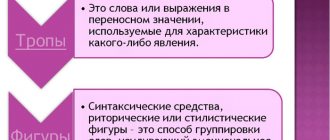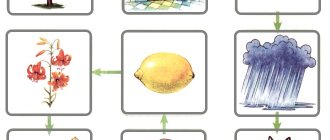Why do we need means of artistic expression?
... life is not the best, but a bad screenwriter, whose shortcomings must be corrected.
(D. Rudoy, “Galaxy of Stars”)
Firstly, knowing in what cases certain techniques are used, it is easier to understand the author’s motivation, his attitude towards the characters, plot twists and events.
Additionally, the ability to identify literary devices can clarify the overall meaning or purpose of a work for the reader. For example, C.S. Lewis's The Lion, the Witch and the Wardrobe is a religious allegory. Understanding this makes it easier to understand why the author uses certain language to describe characters and why certain events happen the way they do.
Finally, the means of artistic expression make texts more interesting, exciting and literary, that is, using creative freedom to create effects and impressions that are impossible in reality. Therefore, those who believe that life is the best playwright do not realize how many thousands of banal stories it requires to create a script that even an average writer can come up with with his eyes closed using only a few tropes, without even touching figures of speech. Literature, and especially good literature, is a very complex and ingenious world, where any detail that seems trivial can be the key to understanding the true meaning and beauty of a work; so if you read a novel without knowing literary devices, you will likely miss many of the layers of meaning embedded in the story.
Metonymy
Metonymy is a type of metaphor. Translated from Greek, this word means “renaming,” that is, it is the transfer of the name of one object to another. Metonymy is the replacement of a certain word with another based on the existing contiguity of two concepts, objects, etc. This is the imposition of a figurative word on the direct meaning. For example: “I ate two plates.” Mixing of meanings and their transfer are possible because objects are adjacent, and the contiguity can be in time, space, etc.
The main means of artistic expression
Although our article examines more means of artistic expression than other sites, we in no way claim to be a complete list and offer only the most common literary techniques that anyone interested in literature and philology must know. Each technique is provided with an example illustrating its essence, and if other successful examples come to your mind, be sure to share them in the comments indicating what means of artistic expression they relate to.
Allegory
Allegory is the use of a memorable image or plot to allegorically express a universal idea, real (historical) problems and/or events. Used in novels and fables.
For example, Orwell's dystopia Animal Farm is an allegory of events leading up to the Russian Revolution and the Stalinist era. In the story, farm animals practice animalism (a reference to communism). Many of the characters correspond to real historical figures.
Another example: Krylov’s fable “The Dragonfly and the Ant,” where the dragonfly symbolizes carelessness and frivolity, and the ant symbolizes hard work.
Allusion
An allusion is an allusion or indirect reference to a person, event, or idea that takes place outside the framework of the main work. Many allusions refer to previously created works of art.
In the poem “The Petersburg Novel,” Brodsky addresses the main character of Pushkin’s “Eugene Onegin”:
We are driven by centuries of persecution, death is just steps away everywhere, now I say hello, Eugene , to you on these shores.
Alogism and paradox
Alogism is a statement in which logical connections are broken. It is used to create a more vivid visual image, often in children's literature.
Toads fly across the sky, fish walk across the field, mice catch a cat, and put him in a mousetrap. (K. Chukovsky, “Confusion”)
A paradox is a statement that is illogical or contrary to common sense at first glance, but in fact turns out to be true or plausible.
As an example, we can cite the famous phrase from Orwell’s story “Animal Farm”:
“All animals are equal, but some animals are more equal.”
Anaphora
Anaphora is the repeated repetition of a sound, word or phrase at the beginning of lines or sentences throughout the text. Used in both prose and poetry. Serves to enhance the emotional impact on the reader.
Example of phonetic anaphor:
“The golden stars dozed off...” (S. Yesenin)
Example of lexical anaphor:
I swear by the first day of creation, I swear by its last day, I swear by the shame of crime and the triumph of eternal truth. (M. Lermontov, “Demon”)
Anachronism
Anachronism occurs when an author needs to make an intentional error in chronology or timeline. This could be a character appearing in a different time period than he actually lived, or technology being used before it was invented. Anachronisms are often used for comedic effect.
In the satirical novel “The History of a City,” Saltykov-Shchedrin uses confusion in dates and anachronisms often made by the chronicler, such as references to Herzen and Ogarev, to enhance the comedy.
Antithesis
Antithesis is the opposition of two or more different (usually opposite in meaning) ideas, characters, things, etc. This technique helps to more clearly characterize an object or idea by comparing them with each other.
At the beginning of A Tale of Two Cities, Dickens uses an antithesis:
“It was the best of times, it was the worst of times, it was the age of wisdom, it was the age of stupidity, it was the age of faith, it was the age of unbelief, it was the time of Light, it was the time of darkness, it was the spring of hope, it was winter of despair..."
Hyperbole and grotesque
Hyperbole is a deliberate exaggeration that should not be taken literally by the reader.
The sunset glowed with one hundred and forty suns... (V. Mayakovsky)
Grotesque is a type of hyperbole. Serves to depict in a caricature or absurd, implausible way any qualities of an object or idea. Often used for comedic effect.
In the novel Gargantua and Pantagruel, Rabelais often resorts to the grotesque when describing the exorbitant size of the heroes:
“Having been escorted into the mouth in this manner, the pilgrims made every effort not to fall under the millstone of his teeth , and already began to think that they were imprisoned in some kind of deep dungeon ...”
Inversion
Inversion means a change in the usual word order in a sentence. Often used in poetry to embed a phrase into a rhythmic pattern.
Can anything in my poems compare with the most tender tears of a mother? (V. Zhukovsky)
Irony
Irony is the use of a word or depiction of a situation in a mocking way, often in a meaning opposite to the literal one. There are different types of irony in literature:
- Verbal irony: one thing is said, but the opposite is implied.
In Dead Souls, Gogol calls the swindler Chichikov “the most decent person.”
- Situational irony: The opposite of what was supposed to happen happens.
In Dickens's Great Expectations, the main character Pip considers Miss Havisham his benefactor. Readers are sure of this too. However, in the end it turns out that Pip's benefactor is an escaped convict.
- Dramatic Irony: The audience is aware of the true intentions or consequences, but the characters are not. As a result, actions and events take on a different meaning for the audience than for the participants.
In Shakespeare's King Lear, the audience knows that Cordelia is Lear's real daughter, but he himself does not know this.
An example of irony is the entire song by Alexander Bashlachev “The Feat of a Scout”:
Malapropism
Malapropism (incorrect usage) occurs when, instead of one word, another word with a similar sound but a different meaning is used. This misuse of a word usually renders the statement meaningless. As a result, this technique is commonly used in comedy.
Oh, don’t get your hopes up: she’s stubborn, like the allegory on the banks of the Nile. (R. Sheridan, “Rivals”).
In this phrase, "allegory" is used instead of "alligator." We hope that, having read this far, you no longer doubt the difference between them. If you are still not sure, this video will help you consolidate the material you have covered:
Metaphor
Metaphor is the use of figurative meaning to describe an idea, action, or object. In other words, one phenomenon is assigned the properties of another. A metaphor can be called an implicit comparison.
From Yesenin:
“There is a fire of red rowan burning in the garden...”
That is, the color of rowan bunches is as bright as the flame of a fire.
Metonymy
Another example of the use of “substitution” in a text is metonymy. It involves replacing one word with another based on the semantic connection between them. This means of expression is usually used to create a poetic effect.
In Pushkin’s “The Bronze Horseman”:
The hiss of foamy glasses and the blue flame of punch.
Here the word “glasses” replaces the name of the drink poured into them.
Multi-union and non-union
When using multiple conjunctions, the author deliberately uses repeated conjunctions, emphasizing the logically and intonationally connected parts of the sentence. The technique serves to enhance the expressiveness of speech.
The ocean walked before my eyes, and swayed, and thundered, and sparkled, and faded, and glowed, and went somewhere into infinity. (V. Korolenko)
Non-union is a reverse technique. It is manifested by repeated omission of conjunctions (and, or, but and, for, etc.) in a group of words or phrases. Serves to emphasize the meaning of a phrase or sentence. Often used in poetry when there is a need to create powerful rhythm or dynamics.
For example, in an excerpt from Pushkin’s poem “Poltava”:
Swede, Russian - stabs, chops, cuts. Drumming, clicks, grinding, The thunder of guns, stomping, neighing, groaning, And death and hell on all sides.
Figurative language
Figurative language helps to appeal to the senses of taste (taste, smell, sight, touch, or hearing) when describing a scene, thing, or idea. This technique helps the reader better imagine what is happening and become more fully immersed in it.
And what kind of pies will my old woman feed me! What pies, if only you knew: sugar, perfect sugar! And the oil just flows over your lips when you start eating. (N. Gogol, “Evenings on a farm near Dikanka”)
An excellent example of a work written entirely in figurative language is “Polyphony” by Yu. Vizbor:
Oxymoron
An oxymoron is a type of paradox, a combination of two words that have opposite meanings. Unlike a paradox, an oxymoron is not a complete phrase or idea, but only forms a phrase. This technique is often used to attract attention, create tension or humorous effect.
Oxymorons are often used in titles of works of art, for example, Kundera's The Unbearable Lightness of Being, Tolstoy's The Living Corpse, or Bondarev's Hot Snow.
Parallelism
Parallelism is based on the repetition of the grammatical structure of a phrase. It can be used as a means of highlighting contrast between opposing phenomena.
The stars sparkle in the blue sky, the waves lash in the blue sea; A cloud is moving across the sky, a barrel is floating in the sea. (A. Pushkin, “The Tale of Tsar Saltan”)
Parcellation
Parcellation is a technique that consists in the deliberate division of a complete sentence into several independent fragments, shorter sentences. Creates the effect of an unexpected pause, and is also used to convey the hero’s internal monologue.
My scarf. He took it. I remember. Didn't I take it back? <…> Behind. It seems there is someone. (D. Joyce, “Ulysses”)
Personification and personification
Personification is the endowment of human qualities or characteristics to an inanimate object or abstract concept. Used to help the reader create a clearer mental picture of the scene or object being described.
And everyone watched and listened from the darkness as the white dress sang in the beam. (A. Blok, “The girl sang in the church choir”)
In personification, as opposed to personification, inanimate figures literally become living beings. This makes it easier for readers, including children, to perceive images, which is why this technique is often used in children's literature.
Suddenly, from my mother’s bedroom, Bow-legged and lame, the washstand runs out and shakes his head... (K. Chukovsky, “Moidodyr”)
Repeat
In repetition, a word or phrase is used several times in a passage, usually to emphasize meaning. Used in both poetry and prose.
I understood the goal and I honor that goal as a goal , and this goal is to admit that I can’t bear to put up with the fact that it is April. (B. Pasternak)
It was love at first sight, at last sight, at eternal sight. (Nabokov, "Lolita")
Omen
Foreshadowing is the author's hint at future plot twists. This technique can be built into dialogue, descriptions, or character actions. Often used to add tension to a story.
For example, in “The Tale of Igor’s Campaign,” a solar eclipse serves as a bad omen, foreshadowing failure in a future military campaign.
Vernacular
Vernacular (colloquial language) is the use of informal expressions and slang. It is often used by authors to add realism to their characters and dialogue. As a rule, it serves to depict folk speech.
In Shukshin’s story “Village Residents,” one of the characters expresses himself in the following language:
“It’s familiar , it could be done now, but Shurka has a very short vacation.”
Rhetorical question, exclamation, appeal
A rhetorical question is a stylistic device that serves to highlight semantic and emotional fragments in speech. Such a question is essentially an affirmation (or denial) of something and does not require an answer.
What Russian doesn't like driving fast? (N. Gogol, “Dead Souls”)
The author resorts to a rhetorical exclamation when he wants to demonstrate the moment of the highest tension of emotions or feelings of the lyrical hero of the work. It is usually in the form of an exclamation or shout.
That was on the morning of our years - Oh happiness! oh tears! O forest! oh life! oh sunshine! O fresh spirit of birch! (A. Tolstoy)
The peculiarity of a rhetorical appeal is that it is not necessary to respond to it. The main thing is the intonation with which the address is pronounced. The addressee of the address can be a person, an abstract concept or an inanimate object.
Oh my easy youth! Thank you for the pleasures, For the sadness, for the sweet torments, For the noise, for the storms, for the feasts, For everything, for all your gifts... (A. Pushkin, “Eugene Onegin”)
Sarcasm
Sarcasm is a more caustic and caustic type of irony with a hint of bitterness. This technique is aimed at criticizing something, such as a person, behavior, beliefs, society, and expresses stronger emotions.
Where, tell us, are the fathers of the fatherland, Whom we should recognize as models? Aren’t these the ones who are rich in robbery... (A. Griboyedov, “Woe from Wit”)
Symbolism
Symbolism involves using a specific object, event, or idea to express a different entity, a broader meaning, other than the literal one. The “carriers” of such encrypted meaning in symbolism are called “symbols”. They usually appear multiple times in the text, sometimes changing meaning as the plot develops.
In Fitzgerald's novel The Great Gatsby, the green light that sits in front of Gatsby's mansion symbolizes the hero's hopes and dreams.
Synecdoche
Synecdoche is a type of metonymy. A literary device in which part of something is used to represent the whole, or vice versa.
From Fet:
“The distance of the sea in the foggy darkness; There the sail is drowning as if in smoke..."
In fact, “sail” refers to the entire vessel. Just don't confuse synecdoche with allegory. For example, in Vladimir Vysotsky’s song “Sail” the latter is used:
Comparison
When comparing, there is a direct comparison of one object, idea, action, etc. with another.
Jim froze motionless at the door, like a setter smelling a quail. (O. Henry, “The Gift of the Magi”)
Flashback
Flashback is a reference to events that have already happened before the time when the story takes place. This technique is often used to give the reader more information and details about specific characters, events, plot points, and so on.
Example: Much of Emily Brontë's novel Wuthering Heights features the memoirs of housekeeper Nellie Dean. In this story, Nelly talks about Catherine and Heathcliff's childhood, their relationship and tragic death.
Euphemism
Unlike an epithet, which draws attention to a word and emphasizes its nuances, the task of a euphemism is to veil. The author turns to euphemism when he wants to express in a softer or more correct form a word or phrase that may be considered rude, vulgar or unpleasant.
Saltykov-Shchedrin’s “Provincial Sketches” says this about the drunkenness of one of the heroes:
“It is clear, however, that in order to strengthen his fading strength, he often resorts to drink , as a result of which his nose has acquired all possible shades of purple.”
Ellipsis and silence
Ellipsis is the deliberate omission of insignificant words in a sentence. Used to encourage the reader to figure out the missing phrase or word on their own. Thus, this artistic medium helps the reader to become more involved in the text.
We turned villages into ashes, cities into dust, into swords - sickles and plows... (V. Zhukovsky)
When using default, the phrase remains unfinished, in the hope that its meaning is already clear to the reader. Often used to create dramatic effect or convey a character's emotions.
By the way, I only have forty rubles, and this money, take it, take it, I don’t know how, I’ll lose it, and they’ll take it from me, and... (F. Dostoevsky, “Demons”)
Emotional-evaluative vocabulary
The author uses emotional and evaluative vocabulary when he strives to more fully express the hero’s attitude to what is happening. At the same time, there is a clear division into vocabulary with a positive and negative assessment.
I didn’t study properly, and the damned Slavic promiscuity is taking its toll. (I. Turgenev, “Asya”)
Epithet
The epithet acts as a special artistic definition; its purpose is to give the word a new, emotionally charged connotation. With the help of epithets, authors can more vividly describe their characters and settings and give the text a richer meaning.
How tender you are, silver night, There is a flowering of silent and secret power in your soul! (A. Fet)
Stone pillars at the entrance to the yard, a snow-sugar yard, cut into snowdrifts by runners, silence, sun... (I. Bunin, “The Life of Arsenyev”)
Epiphora
Epiphora is similar to anaphora, only in this case a repeated word or phrase appears at the end of several sentences. Similar to anaphora, it is used to evoke an emotional response in the audience.
In the poem “The Raven” by E.A. An example of epiphora is the repeated repetition at the end of the stanzas of the phrase “The Raven croaked: “Never”.”
How to find and interpret artistic media
To interpret literary works, you must be able to recognize the means of artistic expression used in them automatically, that is, without thinking. Here are some tips on how to achieve this.
Read carefully and carefully
Do not be tempted to skim or skip any parts of the work. In this case, you may not notice some of the means of expression used and, as a result, misinterpret the text.
If there are any passages in the work that evoke special emotions or interest, you need to take a closer look at them, analyze them for the presence of literary devices. It's also a good idea to re-read any parts that seemed confusing or unclear the first time you read them. This will ensure a deeper understanding of the passage (and the work as a whole).
Remember basic literary terms
It is very difficult to identify literary elements in texts unless you know what they are and how they are used. Therefore, it is worth remembering at least the basic means of artistic expression listed above. Knowing these techniques will make it easier to recognize them in different types of works.
Introduce your target audience
Knowing what audience the author is addressing in his work can make it easier to understand what types of literary devices he might use.
For example, a children's book is most likely to use devices such as repetition or personification.
- What is storytelling? Learn how to create stories you can't put down!
Take notes and mark key passages
This is one of the most important tips. As you read, you should take notes in a notepad or on your computer. It is worth writing down any passages, paragraphs, dialogues, descriptions, etc. that catch your eye or contain a particular literary device.
You can make notes directly on the pages if the book is from a personal library (but not from a public one!). For example, circle key words and important phrases in the text, as well as highlight interesting or particularly effective passages and paragraphs.
Finally, you can use sticky notes to bookmark pages that use a significant literary device. This will help you come back to them later if necessary.
Bookmark on social networks, send by email or print the page:
Metaphor
It is impossible to imagine artistic techniques in literature without mentioning the most important of them - metaphor. This is a way of creating a linguistic picture of the world based on the meanings already existing in the language itself.
The types of metaphors can be distinguished as follows:
- Fossilized, worn out, dry or historical (bow of a boat, eye of a needle).
- Phraseologisms are stable figurative combinations of words that are emotional, metaphorical, reproducible in the memory of many native speakers, and expressive (death grip, vicious circle, etc.).
- Single metaphor (eg homeless heart).
- Unfolded (the heart is “a porcelain bell in yellow China” - Nikolai Gumilyov).
- Traditionally poetic (morning of life, fire of love).
- Individually-authored (sidewalk hump).
In addition, a metaphor can simultaneously be an allegory, personification, hyperbole, periphrasis, meiosis, litotes and other tropes.
The word “metaphor” itself means “transfer” in translation from Greek. In this case, we are dealing with the transfer of a name from one item to another. For it to become possible, they must certainly have some similarity, they must be adjacent in some way. A metaphor is a word or expression used in a figurative meaning due to the similarity of two phenomena or objects in some way.
As a result of this transfer, an image is created. Therefore, metaphor is one of the most striking means of expressiveness of artistic, poetic speech. However, the absence of this trope does not mean the lack of expressiveness of the work.
A metaphor can be either simple or extensive. In the twentieth century, the use of expanded ones in poetry is revived, and the nature of simple ones changes significantly.




